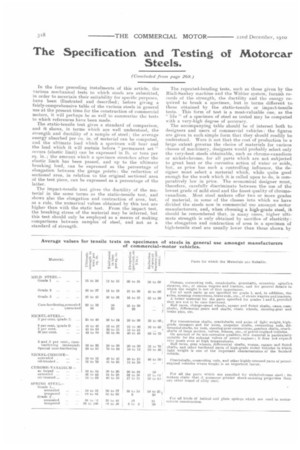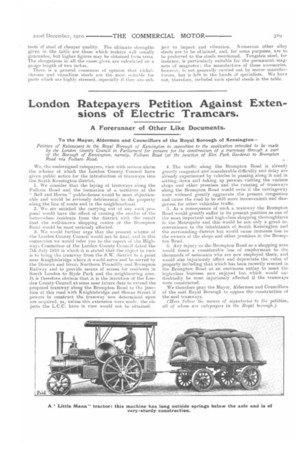The Specification and Testing of Motorcar Steels.
Page 4

Page 5

If you've noticed an error in this article please click here to report it so we can fix it.
In the four preceding instalments of this article, the various mechanical tests to which steels are submitted, in order to ascertain their suitability for specific purposes, have been illustrated and described; before giving a fairly-comprehensive table of the various steels in general use at the present time for the construction of commercial motors, it will perhaps be as well to summarize the tests to which references have been made.
The static-tensile test gives a standard of comparison, and it shows, in terms which are well understood, the strength and ductility of a sample of steel ; the average energy absorbed per cu. in. of material can be computed, and the ultimate load which a specimen will bear and the load which it will sustain before " permanent set " occurs (elastic limit) can be expressed in lb. or tons per sq. in.; the amount which a specimen stretches after the elastic limit has been passed, and up to the ultimate breaking load, can be expressed as the percentage of elongation between the gauge points; the reduction of sectional area, in relation to the original sectional area of the test piece, can be expressed as a percentage of the latter.
The impact-tensile test gives the ductility of the material in the same terms as the static-tensile test, and shows also the elongation and contraction of area, but, as a rule, the numerical values obtained by this test are higher than with the static test. From the impact test, the breaking stress of the material may be inferred, but this test should only be employed as a means of making comparisons between samples of steel, and not as a standard of strength.
The repeated-bending tests, such as those given by the Mall-Sankey machine and the Wohler system, furnish records of the strength, the ductility and the energy required to break a specimen, but in terms different to. those obtained by the static-tensile or impact-tensile tests. This form of test is a most-valuable one, as the " " of a specimen of steel so tested may be computed with a very-high degree of accuracy.
The accompanying table should be of interest both to. designers and users of commercial vehicles: the figures are given ill such simple form that they should readily ben understood. Were it not that the cost of production to a large extent governs the choice of materials for various classes of machinery, designers would probably select only the very-best steels obtainable, such as chrome-vanadium or nickel-chrome, for all parts which are not subjected to great heat or the corrosive action of water or acids, but, as priee has such a controlling influence, the designer must select a material which, while quite good enough for the work which it is called upon to do, is comparatively low in price. The economical designer must, therefore, carefully discriminate between the use of the lowest grade of mild steel and the finest quality of chromevanadium. Most steel makers offer two or more grades of material, in some of the classes into which we have divided the steels now in commercial use amongst motor manufacturers, and, when choosing a high-grade steel, it should be remembered that., in many cases, higher ultimate strength is only obtained by sacrifice of elasticity: the elongation and contraction of area in a specimen of high-tensile steel are usually lower than those shown by
tests of steel of cheaper quality. The ultimate strengths given in the table are those which makers will usually guarantee, but higher figures may be obtained from tests. The elongations in all the cases given are calculnted on a gauge length of two inches.
There is a general consensus of opinion that nickelchrome and vanadium steels are the most suitable for parts which are highly stressed, especially if they are sub
ject to impact and vibration. Numerous other alloy steels are to be obtained, and, for some purposes, are to be preferred to the steels mentioned. Tungsten steel, for instance, is particularly suitable for the permanent magnets of magnetos; the manufacture of these accessories, however, is not generally carried out by motor manufacturers, but is left. in the hands of specialists. We have not, therefore, included such special steels in the table.


















